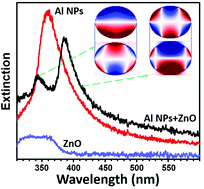Refractive index mediated plasmon hybridization in an array of aluminium nanoparticles
Abstract
The arrangement of plasmonic nanoparticles in a non-symmetrical environment can feature far-field and/or near-field interactions depending on the distance between the objects. In this work, we study the hybridization of three intrinsic plasmonic modes (dipolar, quadrupolar and hexapolar modes) sustained by one elliptical aluminium nanocylinder, as well as behavior of the hybridized modes when the nanoparticles are organized in arrays or when the refractive index of the surrounding medium is changed. The position and the intensity of these hybridized modes were shown to be affected by the near-field and far-field interactions between the nanoparticles. In this work, two hybridized modes were tuned in the UV spectral range to spectrally coincide with the intrinsic interband excitation and emission bands of ZnO nanocrystals. The refractive index of the ZnO nanocrystal layer influences the positions of the plasmonic modes and increases the role of the superstrate medium, which in turn results in the appearance of two separate modes in the small spectral region. Hence, the enhancement of ZnO nanocrystal photoluminescence benefits from the simultaneous excitation and emission enhancements.



 Please wait while we load your content...
Please wait while we load your content...